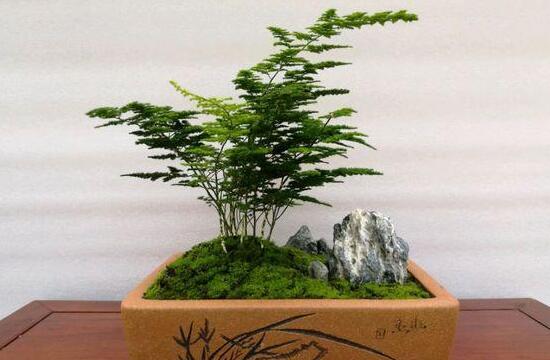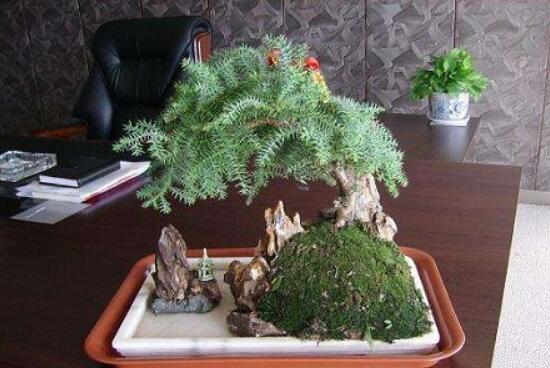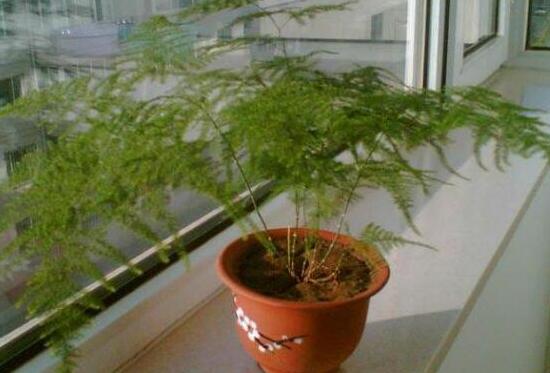How to raise Phyllostachys pubescens, culture methods and matters needing attention / like semi-shade environment
Dwarf asparagus, a variety of asparagus, just like its name, the plant is very short, but it has a beautiful tree shape and bright green color, so it is very ornamental indoors. In life, many people want to raise short asparagus, how to raise it? The following are the breeding methods and matters needing attention of the dwarf asparagus arranged by the editor, which are very detailed. Friends who want to raise them must take a look at them.
First, how to raise dwarf asparagus and understand its habits

Phyllostachys pubescens likes a warm, humid and well-lit environment. It avoids strong light and is not resistant to high temperature. When breeding indoors, it should be placed in a ventilated semi-shady place and warm measures should be taken in winter. As for cultivated soil, it is best to choose loose and fertile soil with good drainage. So how to raise dwarf asparagus? Just satisfy its growth habits.
2. culture methods and matters needing attention of dwarf asparagus
1. Soil
How to raise dwarf bamboos, we should first re-choose potted soil. Because many flower friends' short asparagus bonsai are existing potted plants bought by florists or online, normal maintenance can ensure plant growth. But the soil is relatively cheap, if you want the short bamboo to grow well, you'd better choose again.
Soil selection: according to the growth habits of asparagus, it likes loose and well-drained soil. In this regard, the editor recommends that everyone use: peat soil, perlite, pastoral soil, rotten leaf soil and other soil mixed according to a certain proportion of the soil.
Note: the flowerpot for dwarf asparagus should not be too large, otherwise it will cause water shortage. In addition, the alkalinity of the soil should not be too strong and humus should be added to neutralize it.
2. Lighting
The growth of dwarf asparagus is small, but it is also afraid of strong light, so in the breeding methods and precautions of dwarf asparagus, we should pay attention to light. In summer strong light, should pay attention to shade, let it end sufficient astigmatism exposure; other seasons, if the light is not strong, you can let it out to bask in the sun.
3. Temperature
In the process of breeding dwarf asparagus, timely adjustment of temperature is also very important. Phyllostachys pubescens likes warm environment, the most suitable growth temperature is 5-25 ℃, and it can grow normally when the water is above 10 ℃.
Note: Phyllostachys pubescens is not resistant to high temperature, it will dormancy when it is more than 30 ℃, and when it is less than 0 ℃, the plant is also prone to freezing injury. Therefore, in indoor culture, dwarf asparagus should be put in a ventilated and cool place in summer and keep room temperature above 5 ℃ in winter.
4. Watering
Water is the source of life, so how to raise dwarf asparagus? Watering is indispensable. Dwarf bamboo likes a humid environment, but it avoids stagnant water. If the soil surface is still wet, it does not need to be watered.
Watering method: watering dwarf asparagus should follow the principle of "not clean, watering thoroughly" principle, such as basin soil surface has no moisture, or even dry and cracked state, and then timely watering. As for the watering frequency, it should be determined according to the growth of asparagus.
5. Fertilization
After watering, let's talk about fertilization. It is also a very important part of the breeding method of dwarf asparagus. However, to fertilize dwarf asparagus, we should apply thin fertilizer frequently, not too much fertilizer each time, and not too thick, otherwise it will cause poor plant growth and even death.
Culture methods and points for attention of asparagus how to raise asparagus
Asparagus, an evergreen ornamental plant, belongs to the genus Ophiopogon of Liliaceae from Africa. It is a common potted landscape in the home. How to raise asparagus? The following is to tell you the breeding methods and matters needing attention of asparagus.
Culture methods of asparagus:
1. Soil selection: asparagus is generally suitable for potted plants, because the potted soil can ensure good drainage and good corrosion quality. And the soil should be clean, otherwise it will be harmed. The soil should be moist, and the soil should be loosened in time to ensure the circulation of air.
2. Watering: asparagus does not have strict requirements for water. The general standard of watering is that the soil is dry and then watered. When watering, the leaves should also be watered thoroughly, but pay attention to not causing stagnant water. The air is generally humid in spring and autumn, so it is necessary to water according to the standard, and the soil is easy to dry in summer, so it is appropriate to wet the leaves.
3. Fertilizer control: asparagus is actually not so fond of fertilizer, unlike green pineapple, tiger tail orchid, etc., like rich trees, light fertilizer can be applied, generally mainly nitrogen fertilizer, usually once a month, otherwise because there is relatively little potted soil, and nutrients can not be replenished in time and appear morbid.
4. time of light: asparagus is a semi-shady plant, so it is not suitable to bask in the sun for a long time, especially in summer. Spring and summer can be properly exposed to the sun.
5. temperature regulation: asparagus can grow normally as long as the temperature is above 10 degrees Celsius in daily life, put in a ventilated and cool place in summer, properly watered to cool down, and in winter, it is necessary to keep the indoor temperature above 5 degrees Celsius, otherwise the flowers make asparagus frostbite and die.
6. choice of environment: asparagus is relatively delicate and can be said to be clean, so if you put it in a place with a lot of smoke or smoke, it will make its leaves yellow and dry.
Points for attention in asparagus culture:
1. The soil of asparagus needs to be treated relatively clean, and adding soil during conservation can not add some dirty things. Changing soil and fertilizing regularly is a good guarantee for the growth of asparagus.
2. Asparagus should adhere to the principle of not watering, watering less in spring and autumn, more watering in summer, and no watering in winter.
3. When watering asparagus, we should pay attention to the application of thin fertilizer and more fertilizer, the proper fertilizer is the best and the nitrogen fertilizer is the best. Especially after the plant is fixed, the fertilizer should be properly controlled so as not to cause overgrowth.
4. While illuminating, remember that asparagus is semi-shady and is not suitable for long-term exposure, as long as it is not taken out in summer.
5. Asparagus will blossom, and it is not suitable for blowing when it blossoms, so the flowering period will be very short, and it will not be suitable for Lin Yu. It will also shorten the flowering period, and will not bear fruit. When potted, it should be maintained during the flowering period.
6. if the flowers planted with seeds are used in general, the sowing season is about April, it can grow normally within 3 years, it can split in the fourth year, and it can blossom and bear fruit in the fourth year.
How to raise asparagus, culture methods and matters needing attention of asparagus
The moral of asparagus symbolizes eternal and pure friendship, as well as the romantic love of Tian Chang Di Jiu (Eternal Dumpling), and is often used in weddings. Asparagus can set off the beauty and vitality of flowers. Therefore, asparagus is very popular with people! But raising asparagus is not easy to raise! The following editor will introduce to you the culture methods and matters needing attention of asparagus.
Culture methods of asparagus
1. Watering and fertilization: asparagus should be fully watered during the growing period, and the basin soil must be kept moist, but not too much watering, let alone stagnant water, otherwise it is easy to have rotten roots and fallen leaves, reducing the ornamental value. Watering should be reduced after autumn. During the growth period, thin fertilizers containing ammonia and phosphorus should be applied 1-2 times a month to promote luxuriant branches and leaves, as well as other liquid fertilizers. It should be noted that not too much fertilizer should be applied at flowering stage, and liquid fertilizer should be applied twice in May-June and September-October respectively. The amount of water should be flexibly controlled according to the plant size, based on the principle of seeing dampness. When the branches of the plant are long, they should be tied up in time and trimmed properly to keep the plant neat and beautiful.
2. Planting and turning pot to change soil: asparagus is generally planted in pots. The fleshy fibrous root has strict requirements on the soil in the process of growth. Pot cultivation uses a full mixture of rotten leaf soil and a small amount of fine sand, which requires good soil ventilation and drainage. Change the basin soil once a year. Wait until the root system is full and then replace the large basin. When changing the basin, cut off the outer fibrous root, remove part of the old basin soil, and add new fertile soil. With the growth and height of the plant, a stent should be inserted.
3. Temperature and light: asparagus should be kept indoors in winter, room temperature should be kept above 10 ℃, freezing injury can easily occur below 5 ℃, and the south of China can survive the winter outdoors. The suitable temperature for growth is 15-25 ℃, and Gaoding 32 ℃ will stop the growth and make the leaves yellowing. If the sun shines directly, it will not only cause the leaves to turn yellow, but also appear anxious. Poor ventilation will not only lead to a large number of fallen leaves, but also can not bear fruit. Therefore, asparagus should be furnished indoors or under the shade, but it should not be shaded for a long time and should be placed in a bright place indoors. The end of autumn and winter should be placed near the south window to see more sunshine.
Matters needing attention in asparagus culture
1, nutrient deficiency: potted asparagus, if you do not change the pot for many years, it will cause soil nutrient deficiency. If only water is poured at ordinary times, but not fertilizer, it will also result in insufficient nutrition. Potted asparagus should be irrigated with thin rotten liquid fertilizer once a week, and loosen the soil and water in time.
2, the light is too strong: asparagus likes half yin and half yang, and avoids strong sunlight, otherwise it will cause branches and leaves to turn yellow, so give asparagus shade.
3. Improper watering: asparagus likes to be moist but afraid of waterlogging, so it is appropriate to choose sandy loam with aeration and seepage. Watering properly, more will rot the root, less will make the leaves withered and yellow. When the weather is hot and dry, spray clear water on the branches and leaves every day to increase environmental humidity and compensate for water evaporation.
4. Improper fertilization: if excessive concentration or non-rotten fertilizer is applied, the roots will be hurt and the leaves will turn yellow and fall off. Wash the basin soil with water, dilute the concentration of fertilizer solution, or immediately save it by changing the soil.
5. Smoke pollution: asparagus is afraid of smoke and toxic gases, so it should be placed in the place of air circulation to avoid smoke pollution. You should also often spray water on the branches and leaves to wash away the dust. Advantages and disadvantages of improper placement of asparagus
6. Poor management in winter: asparagus likes warmth and fears cold. In winter, asparagus should be kept indoors in a sunny warm place with room temperature above 8-12 ℃. Long-term shade, at room temperature below 8 ℃, will cause branches and leaves to turn yellow. In addition, watering must be controlled.
Hope that today through the editor's introduction of asparagus culture methods and matters needing attention will be helpful to everyone!
- Prev

Australian fir bonsai how to trim, Australian fir pruning methods / three tricks to create a perfect shape
Australian fir, a kind of evergreen, beautiful plant, it is often made into bonsai to keep indoors, not only good decoration effect, but also good air purification effect! However, if you want Australian fir to look beautiful, in addition to daily maintenance, timely pruning is also very important. So, how to trim the bonsai of Australian fir?
- Next

How to water the dwarf bamboo, and how often is it watered / not dry or watered thoroughly?
For dwarf asparagus, flower friends should be no stranger, it is cultivated by ordinary asparagus, although relatively short, but the leaves are green, evergreen, better ornamental. However, if you want to appreciate the beauty of dwarf asparagus, careful maintenance is very important, especially watering. So, how to water the dwarf bamboo?
Related
- Fuxing push coffee new agricultural production and marketing class: lack of small-scale processing plants
- Jujube rice field leisure farm deep ploughing Yilan for five years to create a space for organic food and play
- Nongyu Farm-A trial of organic papaya for brave women with advanced technology
- Four points for attention in the prevention and control of diseases and insect pests of edible fungi
- How to add nutrient solution to Edible Fungi
- Is there any good way to control edible fungus mites?
- Open Inoculation Technology of Edible Fungi
- Is there any clever way to use fertilizer for edible fungus in winter?
- What agents are used to kill the pathogens of edible fungi in the mushroom shed?
- Rapid drying of Edible Fungi

